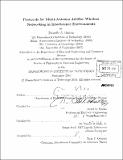Protocols for multi-antenna ad-hoc wireless networking in interference environments
Author(s)
Hinton, Danielle A. (Danielle Ayodele), 1978-
DownloadFull printable version (26.59Mb)
Other Contributors
Massachusetts Institute of Technology. Dept. of Electrical Engineering and Computer Science.
Advisor
David H. Staelin and Daniel W. Bliss, Jr.
Terms of use
Metadata
Show full item recordAbstract
A fundamental question for the design of future wireless networks concerns the nature of spectrum management and the protocols that govern use of the spectrum. In the oligopoly model, spectrum is owned and centrally managed, and the protocols tend to reflect this centralized nature. In the common's model, spectrum is a public good, and protocols must support ad hoc communication. This work presents the design, tradeoffs and parameter optimization for a new protocol (Simultaneous Transmissions in Interference (STI-MAC)) for ad hoc wireless networks. The key idea behind the STI-MAC protocol is 'channel stuffing,' that is, allowing network nodes to more efficiently use spatial, time and frequency degrees of freedom. This is achieved in three key ways. First, 'channel stuffing' is achieved through multiple antennas that are used at the receiver to mitigate interference using Minimum-Mean-Squared-Error (MMSE) receivers, allowing network nodes to transmit simultaneously in interference limited environments. The protocol also supports the use of multiple transmit antennas to beamform to the target receiver. Secondly, 'channel stuffing' is achieved through the use of a control channel that is orthogonal in time to the data channel, where nodes contend in order to participate on the data channel. And thirdly, 'channel stuffing' is achieved through a protest scheme that prevents data channel overloading. The STI-MAC protocol is analyzed via Monte-Carlo simulations in which transmitter nodes are uniformly distributed in a plane, each at a fixed distance from their target receiver; and as a function of network parameters including the number of transmit and receive antennas, the distance between a transmitter-receiver pair (link-length), the average number of transmitters whose received signal is stronger at a given receiver than its target transmitter (link-rank), number of transmitter-receiver pairs, the distribution on the requested rate, the offered load, and the transmit scheme. The STI-MAC protocol is benchmarked relative to simulations of the 802.11(n) (Wi-Fi) protocol. The key results of this work show a 3X gain in throughput relative to 802.11(n) in typical multi-antenna wireless networks that have 20 transmitter-receiver pairs, a link-length of 10 meters, four receive antennas and a single transmit antenna. We also show a reduction in delay by a factor of two when the networks are heavily loaded. We find that the link-rank is a key parameter affecting STIMAC gains over Wi-Fi. In simulations of networks with 40 transmit-receiver pairs, link-rank of three, a link-length of 10 meters, and eight transmit and receive antennas in which the transmitter beamforms to its target receiver in its strongest target channel mode, we find gains in throughput of at least 5X over the 802.11(n) protocol.
Description
Thesis (Ph. D.)--Massachusetts Institute of Technology, Dept. of Electrical Engineering and Computer Science, 2010. Cataloged from PDF version of thesis. Includes bibliographical references (p. 231-242).
Date issued
2010Department
Massachusetts Institute of Technology. Department of Electrical Engineering and Computer SciencePublisher
Massachusetts Institute of Technology
Keywords
Electrical Engineering and Computer Science.